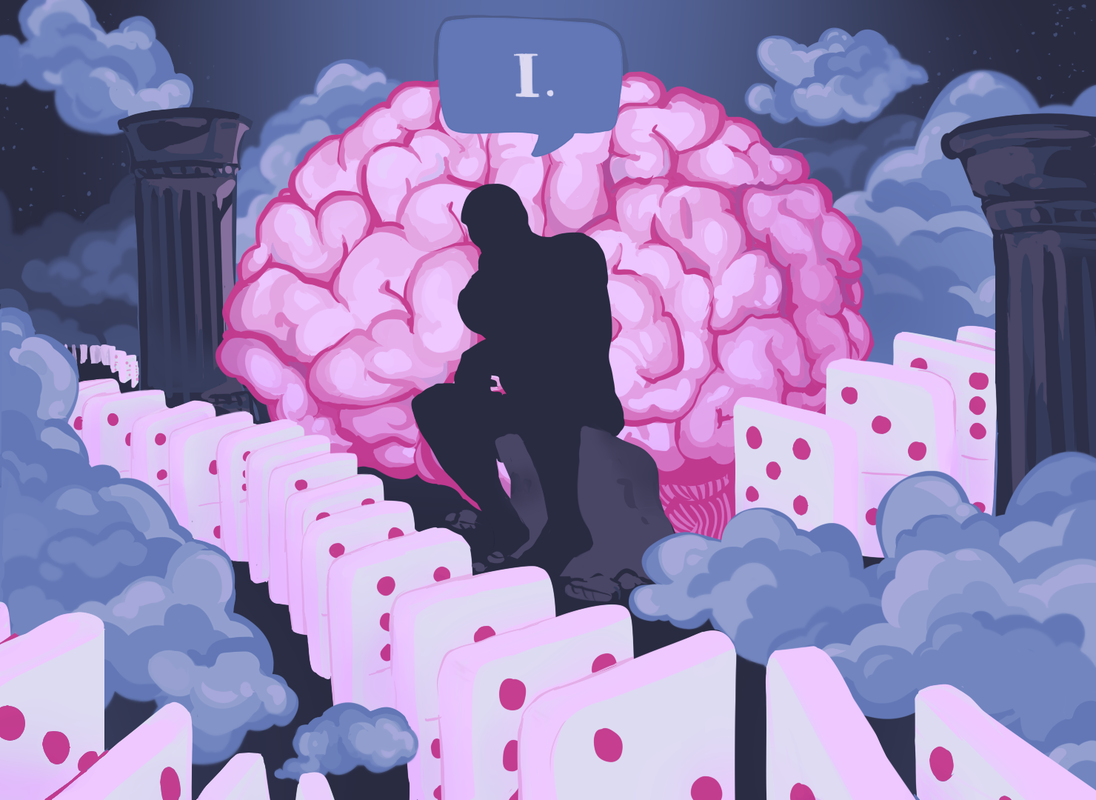|
By Jimmy Liu Of all the common pronouns we use, one stands out from the rest: “I.” People come and go, but the one constant in our lives is our selves. Indeed, the word is so special that we denote its elevated status by capitalizing it. It is a strange convention, especially since no two people ever refer to the same “I” like they do other proper nouns such as “George Washington,” “Microsoft,” or “The Milky Way Galaxy.'' To each of us, “I” is a priori—reality exists for us as long as the self is there to perceive it. Implicit in our special acknowledgement of “I” is the belief of agency, individuality, and at the core, its own reality—“I” is the realest thing in the world. But what exactly is the makeup of this fundamental “I”? Upon closer examination, one starts to find lacunas in the logic of “I.” There are two approaches to analyzing the mind: reductionist and holist. To represent the two views, I will borrow an analogy by Professor Douglas Hofstadter’s book, “The Causal Potency of Patterns.” Imagine a complex chain of dominoes precisely arranged for the sole purpose of carrying out mathematical computations. When given a numerical input (translated as a certain combination of pushes), the domino chain falls (or does not fall) in a particular way, which encodes an output that conveys something about the number it was fed. There might be, for example, one lane for divisibility by two, one for divisibility by three, one for primality, and so on. Now, imagine a bystander, who has not been told what the dominoes are made for, witnessing the number 641 being fed into the chain of dominoes. She points at the prime lane and asks: “How come that lane of dominoes fell?” If I were a reductionist, I would take pain to describe how the particular set of pushes caused the specific physical arrangement of the chain to fall in this way. This first explanation does not concern itself with the meaning of the encoded pushes or that fallen lane of dominoes—it simply regurgitates the deterministic process that leads to the result. By going down to the finest grain of detail, all information is preserved—at the expense of the emergent meaning formed by the interaction of the chain. On the other hand, the holist’s answer is much more concise: “Because 641 is prime.” As opposed to the reductionist explanation, this sentence is imbued with a higher-level meaning which emerges from the lower-level mechanism of the domino chain. Without ever referencing the building blocks of the chain, this answer makes total sense to someone who is familiar with the system but elicits from the bystander a scratch of the head: “Come again?” Now would be a good time to tell her that each lane represents divisibility by some number. One might feel prone to ask: whatever does this hypothetical domino chain have to do with analyzing the mind? When it comes to the question of consciousness, our brain works like the domino set-up in that meaning emerges from individually meaningless neural firings, much like 641’s primality emerges from falling dominoes. The difference, however, is that our perception can only operate at the macroscopic scale on a day-to-day basis, where meaning exists at the expense of what goes on beneath the surface. From an evolutionary standpoint, forgoing microscopic awareness is a gift; imagine trying to survive while constantly being aware of your billions of neurons! While the proposition is purely hypothetical, modern science has brought us closer to a more intimate understanding of our brain, with one exception: in the dominoes chain analogy, somebody had to start the cascade by pushing on the first domino. For example, when I decided to take my coffee black this morning, I was not aware of the patterns of neural activity leading up to my foregoing the sugar. Instead, I was thinking about the many Zoom classes in the day ahead. To me, it did not seem the least bit strange that I simply willed myself not to reach for the sugar. Who exactly is the “Prime Pusher” in our brains? If we cite “I” as the Prime Pusher, the question then shifts to where this “I” is localized—for if the mind were first in the causal chain, then it has to exist somewhere. Before science can provide a definitive confirmation of its localization, all we can fall back on is that it is an emergent phenomenon from neuron firings, much like 641’s primality is an emergent phenomenon of the falling domino chain. In other words, the self is caused by patterns of neural activity, existing alongside other abstractions in our head—soap opera, shame, schism, scholarship, sophomore. Remember that the conclusion we have reached followed from the assumption that the self-caused patterns of neural activities resulted in my forgoing the sugar. Combining the premise with the conclusion gives us a depiction that is strange to say the least. The “I” seems to at once cause and be caused by neural activity—it is a self-reinforcing loop. How can we possibly reconcile the self’s impossible “double causality” with all other observed physical phenomena? Should we throw in the towel like David Hume did and declare that the “I” is an illusion? Should we insist, as Zen Buddhists do, upon this paradox as necessary for the inception of “I”? Perhaps, instead, we should accept that the “I” is a byproduct acting as a useful shorthand that imbues the meaningless squirting of chemicals at a microscopic level with perceived meaning. No matter how we come to terms with the strange loop that the self entails, there is no denying that we feel deep down that the decision-making “I” is real—at the end of the day, no amount of philosophizing can alter instincts. However, when we go upstream along the river of downward causality, we find ourselves hard-pressed to locate its source.
0 Comments
Leave a Reply. |
Categories
All
Archives
April 2024
|

